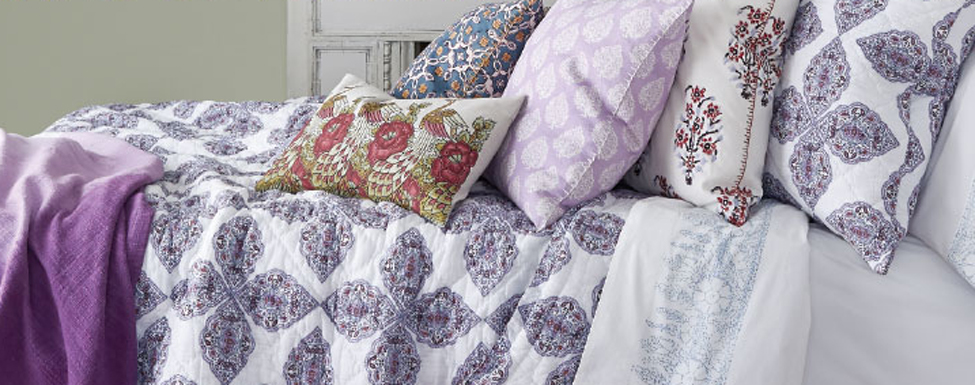John Robshaw
The Master of Eclecticism
John Robshaw lives for color. There is never enough and the brighter the better. He has built his stellar reputation as master textile designer by creating an assortment of extraordinary fabrics based on inspirations from his fabled travels.
Robshaw earned his fine arts degree at Pratt Institute and spent some time as an assistant to artist Julian Schnabel. But it was his trip to India in 1990 that started his romance with fabric and color.
He went to find natural indigo dye to use in his paintings but wound up being fascinated with the fabric-making traditions of local artisans. He was inspired to create his own indigo-washed textiles and block prints. And as they say, the rest is history.
Today the John Robshaw Collection includes everything from bedding, pillows, bath and beach, décor and accessories (including everything from tabletop to stationery) and fabrics by the yard. His designs are carried by some of the finest merchants in the business, from Saks Fifth Avenue to Bloomingdale’s to Neiman Marcus and Anthropologie.
His sense of color is extraordinary and obviously influenced by the vibrancy he experiences in the various villages and countries he visits to gather inspiration. He has created court batiks in Yogyakarta, Indonesia; made block printed sarongs with a native family upholding a printing process for four generations. His inveterate travels have enabled him to discover the techniques and talents of artisans all over the world. Robshaw then puts his unique spin on what he has discovered.
“I want all the colors, techniques and designs from each culture to blend. I edit them, I learn from them, make them my own, but always retain their original essence,” says Robshaw. “Many of the printers are old, their hands are shaky and their eyesight is poor, so the pattern comes out slightly off, so it has the human touch.”
When he isn’t off on an exotic treasure hunt, Robshaw divides his time between New York City, where his offices are located, and Sharon. Seven years ago, he purchased an early 19th-century cottage on eight acres. However, don’t expect to find period furniture and priceless antiques. Instead he has filled his residence with vibrant hues and patterns that confirm his love and understanding of color and how to use it to the maximum.
In explaining his philosophy, Robshaw once said, “I enjoy that kind of collage in which things don’t quite make sense.”
But in a careful analysis of what he does, everything makes sense because he takes such care in what he creates and how it is presented.
Then there is the story of the maharajas. Robshaw has a collection of paintings of India’s princes that he has collected on his trips over the years. While the paintings are not antique, they emit a feeling of grandeur and of what life in India was like centuries ago. Robshaw bought them for a modest sum and thought he would incorporate them into one of his design projects. The perfect pillows perhaps?
“Turns out, no one liked the maharajah pillows and I couldn’t sell them.”
However, Robshaw has one in the living room of his Sharon home as a reminder of the experience. And the maharajah paintings hold court in his studio.
“These guys are a fun gang,” he says. “It’s fun to have a little bit of India here in Connecticut.”
As a textile designer, Robshaw is prolific. No matter what style, taste or sensibility, one is bound to find inspiration in his work and harbor the desire to own one or more of his creations. In his book John Robshaw Prints: Textiles, Block Printing, Global Inspiration, and Interiors, he describes his journeys to India, Southeast Asia, and other far-flung countries and cities and explains how he interprets images and experiences for his designs. It is just an image or an object; he is inspired by the origin of the object, the person who made it and how it reflects the environment around it.
Nothing is sacred and everything is subject to interpretation. “I travel a lot and collect all colors, shapes and sizes from old Samarkand carpets to art school paintings to demons from Sri Lanka,” he said.
For more information please visit the link below.

